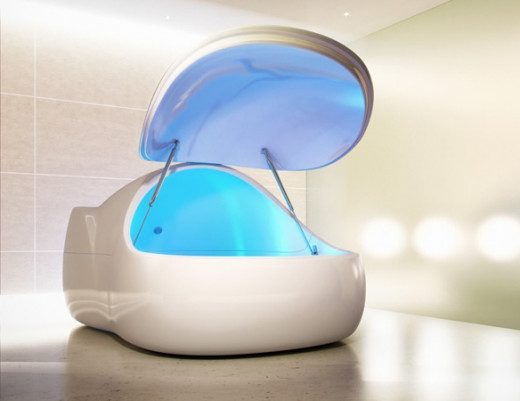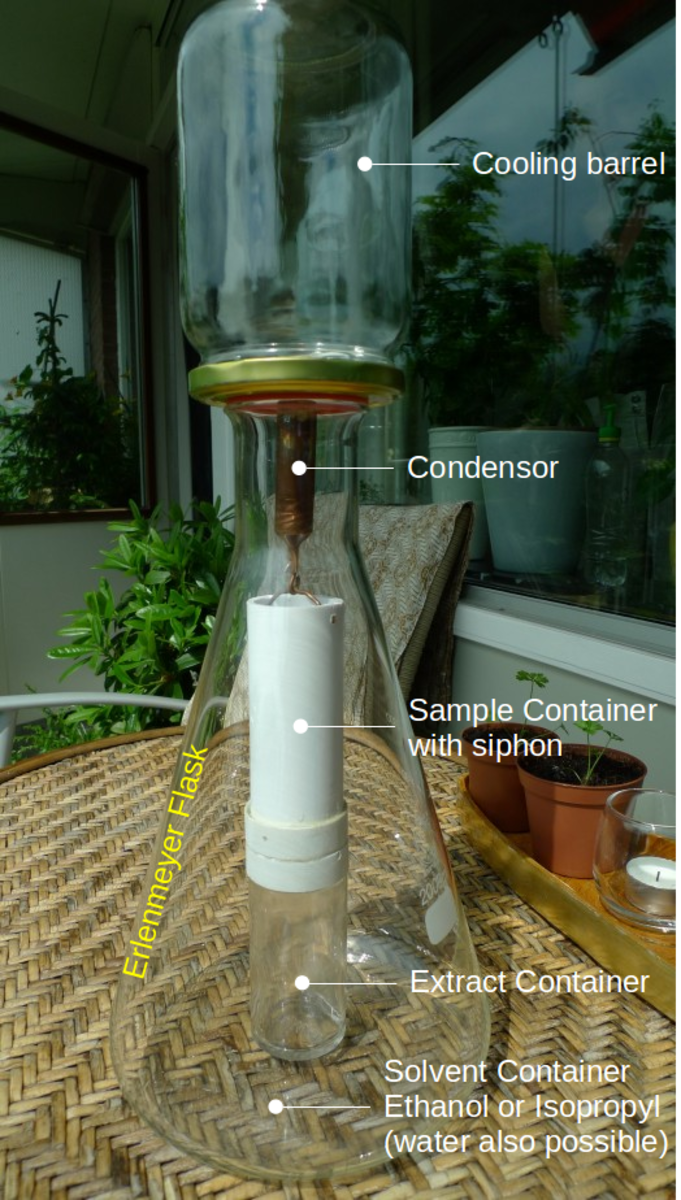Isolation Tank, What Is It?

At first the isolation tank reminded me something out of a creepy science fiction thriller. A fluid filled, womb like chamber aimed at removing the constant stimuli provided by the world around us. Not to mention the names that these tanks go by. Sensory isolation tank, sensory deprivation tank, floatation tank; of course one would be nervous after hearing all of those. The fact that most of these vessels reside in salons and businesses offering massage therapy should have steered my opinion in the proper direction.
My ignorance was revealed only moments after I exited the isolation tank for the first time. Little did I know that the Epsom salt soak in total darkness would leave me feeling more refreshed than I may have ever felt. There is a large amount of potential for stress relief, muscular and joint relief, and accelerated learning from using the tank. Floating in an isolation tank can also help with conditions such as depression, jet lag, fibromyalgia, muscle aches, and many other issues.

What does an isolation tank look like?
The isolation tank was not invented with the claustrophobic in mind. Float tanks create an enclosed space allowing for control over light, temperature, and, in a way, sound while using earplugs. They are roughly five foot wide and eight foot long; with a height of around four feet. Earlier models are entered through a square hatch placed on one end of the tank. Modern models are equipped with a clam shell design making it easier to enter and exit the tank safely and comfortably. This is much more appropriate for a therapy situation.
There are plans and articles for home built tanks online. However, I would suggest using your local float center or buying a professionally made isolation tank to avoid problems. On the other hand; if you are the crafty or adventurous type www.FloatTankShop.com has a free set of plans to build your own at a much lower cost.
Inside of the isolation tank there are ten inches of magnesium sulfate(Epsom salt) saturated water. Eight hundred to a thousand pounds of Epsom salt actually. The magnesium sulfate increases the density of the water allowing a person to float effortlessly. It also softens and re-freshens the skin. After a tranquil, hour long float I feel like I am glowing.
Those of you adhering to a "cleanliness is next to godliness" lifestyle should not fear. Commercial tanks are extremely sanitary. Filtration and disinfection systems are employed between every float session. Isolation tank sanitation structure usually consists of ultraviolet sterilization, skimmers, cartridge filtration, and chemical disinfection. Although patrons usually float in the nude to reduce tactile stimulation; showering before and after your float is expected. This drastically cuts down on the amount of oils and sediment that enters the tank.
History of the isolation tank
John C. Lily
The development of the isolation tank begins in 1954. While employed at the National Institute of Mental Health a physician and neuro-psychiatrist named John C. Lily had been experimenting with different forms of sensory deprivation. His research in the nature of human consciousness eventually led to the design of the isolation tank that we use today. The question of what the brain's energy source is and what would happen if stimulation was cut off to the brain was posed. While finding ways to study these hypothesis the tank was born.
Lily made contributions to a large part of the scientific community. One of which was helping the creation of the United States Marine Mammal Protection Act of 1972. Lily also did extensive research on inter-species communications between humans and dolphins. During World War II Lily invented instrument for measuring gas pressure. These instruments were used for high-altitude flying and research.
Isolation Tanks in the Media
You don't come across the isolation tank in popular culture or media very often. That may also be a driving force in the strange curiosity people have about floating upon discovering it. Thankfully there are a few outlets to aid in the research of floating while slowly driving it into the mainstream focus.
The Vice Media network provides very thorough news pieces on floating culture and isolation tanks. These videos hit very close to home for me as they were filmed at my preferred float center, Cloud Nine Float Center in Boulder, CO. They can more easily be found at Vice's Youtube page. The reporter holds informational interviews with everyone from tank designers to first time floaters.
Isolation tanks have also been used in film and television. In the first episode of the popular science fiction show Fringe Dr. Bishop uses the isolation tank to connect two peoples minds. Obviously this does not happen from floating; maybe in the future? In the movie Altered States the isolation tank is featured as an integral part of the film. A scientist at Harvard uses an isolation tank alongside of psychedelic drugs. This causes him to regress into a ravenous ape and run amok.
One of the isolation tank's biggest revivalists is Joe Rogan. Rogan has his own isolation tank installed in his home and continuously talks about it on his podcast The Joe Rogan Experience. I had seen and even owned the film Altered States, but never thought to seek out an isolation tank for my own use. I just put the idea in the back of my head chalking them up to an expensive scientific piece of equipment that I would never get a chance to use. After listening to Rogan's podcast I decided to search for Denver isolation tanks. Lo and behold A New Spirit had multiple tanks and was close to a bus stop. So begins my love for floating.
Isolation Tank Benefits
Float therapy and the relaxation it provides is the ideal environment to place your body into a healing state. Floating is phenomenal for relieving stress, anxiety, pain, swelling, insomnia, jet lag, and many more issues. Research from Ohio State University has shown that floating even improves creativity in Jazz musicians.
Physical Stress
The large amount of Epsom salt causes the water to be denser than your body. This density allows you to float freely with no pressure on the skin or muscles. This combination of free floating and a skin temperature water allows the body to relax its postural muscles. This relaxation sends a message to the brain saying "Go ahead and relax. You're in the perfect environment.". With no pressure on the outside of the skin like a bed would create, your blood vessels are allowed to fully relax and increase blood flow. This increased blood flow can promote faster recovery rates and put you into a naturally relaxed state.
Mental Stress
Floating may be one of my favorite forms of meditation. It can bring me to the point of nearly falling asleep, or send me into a wonderful internal journey of my own consciousness. Researchers have found that floating in an isolation tank can bring on the same brain waves that day dreaming is synonymous with. Floating can be compared with other stress management techniques, such as long vacations, in decreasing the levels of cortisol in the body. These lower levels of cortisol greatly reduce the amount of mental and physical stress. A sixty minute float session is much easier on the pocket and vacation days when compared to a vacation.
Epsom Salt
Epsom salt is another name for Magnesium Sulfate. It has been used medicinally for centuries on many different health issues. Epsom salt can be found in many spa waters around the world. Magnesium sulfate is non toxic and there should be no worries if it is swallowed. More recent research has found that floating in Epsom salt actually help with magnesium deficiency. The magnesium is absorbed into the skin while soaking during the float.
Probably the most noticeable benefit from the magnesium sulfate is the way it makes your skin feel. After every float my skin feels amazing! All of the hard, rough callused areas become extremely soft creating a feeling of youth and vigor. This refreshing feeling usually last me a couple of days.
Feel Better From Floating
- Relax Muscles
- Rest Joints
- Increase Blood Flow
- Relieve Stress
- Regulate Magnesium Levels
- Soften Skin
Go Float!
So get out there and float. I would bet the bank that you will be ranting and raving about it as much as I do after your first experience. In this fast paced world people should always find a little bit of time to set aside and relax. It is important to our health as well as the people around us. If you have even the slightest interest in isolation tanks please do not hesitate. You owe it to your body to take a load off.
Had you heard of isolation tanks before this article?
Are you prepared to float?
Do you have an appointment but are nervous or just curious about the whole experience? Would you like to be prepared for that first float? Check out my other article on isolation tanks.







